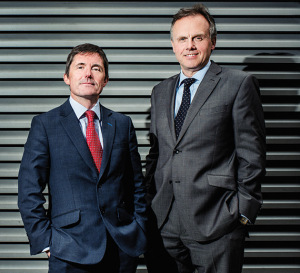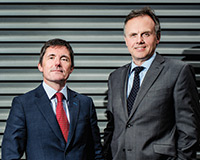With speculative development back on the market, Richard Sullivan, director, industrial & logistics at Savills, and Nigel Godfrey, executive director and UK head with IDI Gazeley, discuss occupiers’ needs, where the ideal development locations are, rental levels, lessons learned and shortage of stock. Portraits by Matthew Joseph
 Level of speculative development
Level of speculative development
Richard Sullivan: , That is anywhere from recently announced, to on site, to practically completed, and we tot that up to make about 5.5m sq ft of speculative development in the UK right now. It is lower than pre-recession by a country mile.
For instance, in 2007 when the wheels stopped turning, Prologis had 18 buildings, totalling 6m sq ft, and that was just one player in the market.
Nigel Godfrey: There was something over 20m sq ft of spec space at the time – quite extraordinary – and now we have got a situation where some localities are down to about three months’ supply of stock, which is, in part, driving people to want to spec build.
IDI Gazeley is building 600,000 sq ft in three buildings at Enfield, Magna Park and Daventry, and we are going to follow that up in the second half of 2015 by another 400,000 sq ft, in two buildings at Lutterworth and Bedford, so by the end of 2015 we will be speculatively constructing 1m sq ft.
We design the buildings to be attractive to as many potential customers as possible. The buildings are largely divisible in two, with two separate car-parks, or provision for two separate car-parks, but in the UK market most of those buildings will be let to a single occupier. And the market that is active at the moment is e-commerce.
RS: The 3PLs have been increasingly active in absorbing all the grey space, as we call it, which used to be [from] contracts coming to an end, giving rise to some vacant accommodation.
NG: Retailers and third-party logistics contractors probably account for about 80% of our UK business. Those customers are very significant.
Leases
NG: The lease lengths retailers take depend on who it is. Generally, they take long leases of 25 to 30 years. The 3PLs will typically take as short a lease as they can, certainly 10 years or less, but we struggle to get 3PLs to take anything in excess of 10 years. Ideally, 3PLs want to take leases that match the length of the contract with their customer.
Stock shortages
NG: The shortages are in the South East, and in the Golden Triangle. And there is a significant shortage in the North West right now.
RS: There has been a slightly delayed reaction in the North West to spec build. Nothing has really been built up there, other than on a build-to-suit basis, for some considerable time. As a result, we are starting to see a shortage of built stock in a market where the major conurbation is Manchester and the surrounding area.
This is a strong market for proximity to consumers, and customer fulfilment-type centres like the Hut Group, which has just taken 600,000 sq ft [at Warrington’s Omega South Site] quite recently. Admittedly, that’s on build-to-suit. On a spec basis there are a few coming through. For example, in Trafford Park there is 175,000 sq ft under construction for M&G, while in Wigan, L&G and DB Symmetry are looking to build 180,000 sq ft.
Rental levels
NG: Due to the imbalance of supply and demand at the moment there is upward pressure on rent. So, for the first time I can ever remember, we are predicting rental growth for the next few years, which is great for the industry. Value isn’t all about cap rate compression, it is about rental growth, as well.
RS: This is good because rental growth has never been a prevalent phenomenon in the industrial and logistics market. For the first time in a long time there is evidence of real growth, so that’s great for an investor, and for a developer. I think occupiers are acknowledging [that if they] secure the right premises on a quality specification, then they accept increasing rental levels.
One or two might get into the realms of affordability, but staff employment is probably the highest cost for an operator. We never felt that property cost as a fixed cost in that process is prohibitive, but I think it is going to be one to watch.
NG: We have had a number of years where there was an excess of supply over demand and deals were very much cut in the occupier’s favour. Now it is certainly moved back to being in favour of developers and landlords. The average rise is probably going to be up to 2.5% pa, year on year, although some are predicting it is going to be greater. I would imagine there will be some markets like Heathrow and Park Royal, where you might see that moving.
RS: Yes, albeit they are coming off historically quite high rents in the first place, so it will be interesting to put 50p on the rent in Park Royal, which is actually not a very high increase when you’re already at £14 per sq ft. Whereas going from £5.50 per sq ft up to £6.50 per sq ft, which we are seeing now in the Golden Triangle, is a much more significant increase, percentage wise.
Occupier demand
NG: One factor we have got, and this is shown by our experience on seven sites at the moment, is more than one occupier looking at a building at the same time. This is a great situation for us to be in.
RS: That has actually been quite a rarity as well, hasn’t it? In reality, often you only need one occupier to take a building to make it competitive. But where you have got two occupiers wanting to take the same building… it is artificially driving rents even higher than they should be, but ultimately it all comes out in the wash.
Financing and development
NG: There was a time, a rather uneducated time, when everybody was piling into the back of an already saturated market, but developers are being far more cautious about where and at what scale they build. We all have memories of the peak of the last cycle and how quickly that fell off a cliff. I don’t think that will be repeated.
In terms of the finance availability for spec development, there are people building off their own balance sheet.
There are other developers for whom third-party financing is absolutely essential; they would be either financed by banks, while a number of funds are taking positions.
There’s more funds actually developing… and the funds are taking control of those developments. It is a repeat of what happened in the last cycle, and the funds are cautiously moving up the risk curve.
RS: What’s different to the last time [before the recession] is the number of sites you could buy right now that are development ready and that could help satisfy some of the latent demand are relatively few and far between. So the ability to just go on site tomorrow and knock up a shed is not what it was seven or eight years ago.
I’d also like to think that the market is generally more mature. There’s more data available. Firms like us, and others, are tracking much more closely who is doing what in the market, so Nigel can instantly know whether a competitor is about to launch a spec scheme around the corner from something that he’s planning. And equally, if IDI Gazeley announced a spec programme in certain locations, then that’s going to sound a note of caution to another developer to come and do something similar nearby.
NG: Yes, we go into a great deal of analysis to justify any particular speculative development, so we look at the local market, the demand; we look at the stats that people like Savills produce in great detail, so it’s a very careful and measured approach to speculative development.
In association with Savills and IDI Gazeley











